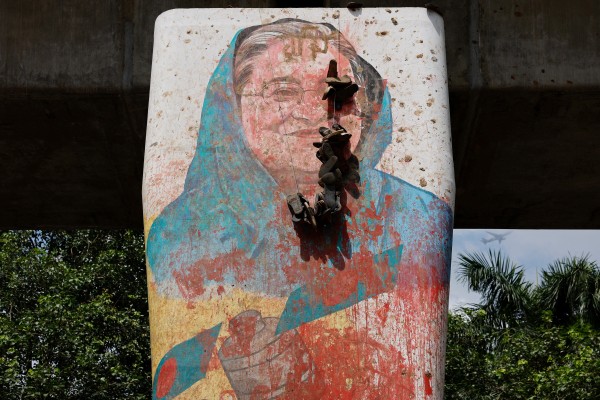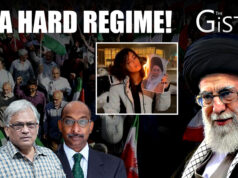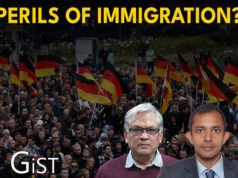
DHAKA: There was jubilation and also lingering anger on the streets of Dhaka after mass protests forced Bangladesh Prime Minister Sheikh Hasina to flee the country, but minorities worried about what would happen next.
“We are free now – we have won!” said Syed Tanveer Rahman, 30, an activist in the movement that began as protests against quotas giving government jobs to people seen as Hasina allies, but morphed into mass demonstrations against her rule.
Hasina was accused of becoming increasingly authoritarian, with some young protesters describing her as a dictator.
The mass demonstrations were partly fuelled by poverty. The government had sought a bailout from the International Monetary Fund as the economy struggled with costly imports and high inflation.
“I can tell you I am feeling a tremendous joy of liberation – liberation from a harsh dictatorship,” said Lamisa Janan, a high school student.
Some normality returned to Dhaka on Tuesday, a day after Hasina fled, though traffic was lighter than usual and only a few schools reopened after the violence.
About 250 people were killed and thousands injured as security forces attempted to stamp out the protests.
But even after Hasina left, there was still anger amongst the joy.
Hasina’s exit ended a 15-year second stint in power as leader of a political movement she inherited from her father who was assassinated in a 1975 coup.
Thousands stormed Hasina’s official residence, and some were seen carrying away televisions, furniture and clothes.
At a busy intersection, protesters climbed a large statue of Hasina’s father, independence leader Sheikh Mujibur Rahman, and hacked at its head with axes, hammers and chisels.
🚨 DISTURBING FOOTAGE ⚠️
🔸️Violent mob vandalizes the statue of Bangladeshi freedom fighter & the 1st PM of #Bangladesh, Sheikh Mujibur Rahman, as the radical mob storms 🇧🇩PM Sheikh Haseena's residence & loot furniture & other items, amidst her exit from the nation. https://t.co/UyUsDKDbr6 pic.twitter.com/bfrFH9lWhk— Subcontinental Defender 🛃 (@Anti_Separatist) August 5, 2024
“She made us bow down to the image of her father. Everywhere you see his statues, photos,” said Zafar Ahmed, a young man who joined in the destruction. “We will destroy all the statues.”
‘TIME TO REBUILD FROM THE RUINS’
In Dhanmondi, an upmarket neighbourhood considered a stronghold of the ruling Awami League, protesters torched the party chairperson’s office and the house where Hasina lived while she was opposition leader from 2001 to 2006.
They also set fire to the Bangabandhu Museum in Dhanmondi, formerly Hasina’s father’s residence before he was assassinated there in 1975.
“I am sickened by the scenes of chaos and looting at the public institutions – that is not the way to celebrate,” said Jahanara Amin, a 35-year-old banker.
“It is not the time for triumphal celebration. There is a long road ahead to ensure that the system works better for everyone, including the young people,” said Minhazul Islam, a researcher at Unnayan Shamunnay, a policy think tank.
Bangladesh’s parliament was dissolved on Tuesday, after protesting student leaders set a deadline for that to happen and warned of a “strict programme” if it did not.
Student leaders have demanded Nobel laureate Muhammad Yunus lead an interim government. The founder of the global microcredit movement, Yunus was an arch foe of Hasina, who in turn accused him of “sucking blood from the poor”.
Writer and activist Parvez Alam said there was now a chance for a new Bangladesh to emerge.
“The young people in Bangladesh have been calling for ‘repairing the state’ for the last 10 years or so, based on core values like equality, human dignity, and social justice,” said Alam. “The July uprising provides us an opportunity to rebuild our state from the ruins.”
Others called for more openness and freedom.
“Bangladesh should have the space for people of all religious creeds, lifestyles, opinions – allowing the right to ask questions, make cartoons or satire and so on,” said Farida Ali Khan, a young housewife and mother.”The only thing that should be excluded is dictatorship.”
Hundreds of Hindu houses, businesses and temples have been vandalised since Hasina’s ouster, and neighbouring India said it was worried about the incidents.
My heart is breaking, my eyes are crying. I believe in the power of prayer, I believe God answers prayers. Everybody please say a prayer for the Hindus in Bangladesh. God really does answer prayers. Please pray and help if you can. Tell everybody to pray🙏 #BangladeshViolence pic.twitter.com/N3XRfvfMeT
— Renee Lynn (@Voice_For_India) August 6, 2024
Hindus constitute about 8% of Bangladesh’s 170 million people and have historically largely supported Hasina’s Awami League party, which identifies as largely secular, instead of the opposition bloc that includes a hardline Islamist party.
India, now sheltering Hasina after she fled on Monday from deadly protests after 15 years in power, said what was “particularly worrying was that minorities, their businesses and temples also came under attack at multiple locations”.
The Bangladesh Hindu Buddhist Christian Unity Council (BHBCUC) said 200-300 mainly Hindu homes and businesses had been vandalised since Monday, and 15-20 Hindu temples damaged. Up to 40 people have been injured though not seriously, its general secretary, Rana Dasgupta, told Reuters.
“The situation is horrific,” said Manindra Kumar Nath, a Hindu community leader. “Even today, we are getting calls from people asking us to save their lives, but we are not receiving any support from anywhere.”
The military’s media office said security forces were helping maintain law and order across the South Asian nation, without specifying any incidents.
Students who led the protests against Hasina have repeatedly urged people not to target minority communities in the overwhelmingly Muslim country. But Hindu community leaders said they were feeling vulnerable because of the lack of a functioning government.
(Reuters/Thomson Reuters Foundation)
In a career spanning three decades and counting, Ramananda (Ram to his friends) has been the foreign editor of The Telegraph, Outlook Magazine and the New Indian Express. He helped set up rediff.com’s editorial operations in San Jose and New York, helmed sify.com, and was the founder editor of India.com.
His work has featured in national and international publications like the Al Jazeera Centre for Studies, Global Times and Ashahi Shimbun. But his one constant over all these years, he says, has been the attempt to understand rising India’s place in the world.
He can rustle up a mean salad, his oil-less pepper chicken is to die for, and all it takes is some beer and rhythm and blues to rock his soul.
Talk to him about foreign and strategic affairs, media, South Asia, China, and of course India.




